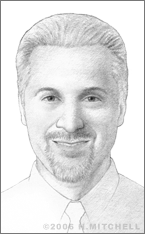Howard Dananberg
Women around the world have for centuries enthusiastically chosen to wear high-heeled shoes in the name of fashion, despite the pain and even serious injury they can inflict on the wearer, including toe, heel, knee, and back pain.
Podiatrist Howard Dananberg had seen all too many cases in his Manchester, New Hampshire practice of women stricken with foot dysfunction and lower back pain caused by their high-heel habits. Beginning with research conducted in the 1980s, he set out to remedy the problem. The end result was Insolia, a geometrically designed shoe sole technology that very well may be just what the doctor ordered for millions of fashion victims.
Born in New York City in 1949, Dananberg attended Stuyvesant High School and Queens College before entering the Ohio College of Podiatric Medicine in Cleveland in 1971. He earned a doctoral degree there in podiatric medicine in 1975, and after completing his residency, he entered into a private practice in Manchester, New Hampshire. Dananberg became immersed in the study of in-shoe pressure analysis and its use in the treatment of chronic musculoskeletal pain. He began doing research to develop novel techniques and technologies that have been successful in helping men and women relieve a variety of walking-effected symptoms throughout the body.
One of his most important discoveries was of the phenomenon of sagittal plane foot dysfunction and its effect on gait style and mechanical overuse. Dananberg received the 1994 Scholl's Award for Outstanding Clinical Paper of the Year for his series of articles detailing the ways in which foot dysfunction can impact posture and gait, which was published in the Journal of the American Podiatric Medical Association. In 1999, he published a two-year outcome assessment study describing the effects of gait style on chronic lower back pain.
In pursuit of his research interests, Gananberg became involved with computerized in-shoe pressure testing in the early 1980s. A new shoe construction that he patented and invented, which was known as the “Kinetic Wedge,” improved the comfort of running shoes. He licensed the technology to the Brooks Running Shoe Company, which came up with its commercial name. Dananberg learned a great deal about the shoe industry through this experience, and, responding to a patient’s challenge, he began to look toward an even more difficult problem: how to make high heels more comfortable.
He began his research by asking women walking on city streets about their walking and fashion habits. He quickly determined that a great market opportunity existed for a technology that could fit into fashionable, sexy-looking high-heeled shoes. His concept would have to be adaptable so as not to change the look of high heels. This would prove to be very important.
Dananberg learned that for women, walking in high heels was much like walking downhill. Weight was shifted to the ball of the foot, as if the wearer were standing on a ramp. This can cause all sorts of problems, including bunions, hammer toes, and knee and back pain. Dananberg realized that if he could find a way to shift the weight back toward the heel to create a more evenly distributed pressure relationship, high heels might begin to feel like flat shoes.
Using F-Scan technology to map pressure points exerted by the foot at various heel heights, he was able to create a flexible insole that would put the foot in optimal position. The construction, which he called a “cup and bump,” cups the heel and increases the contact area throughout the sole so that high heels suddenly feel about half as high as their actual height.
After perfecting the concept in 1997, Dananberg patented the technology. Insolia inserts, which consist of an adhesive heel cup and forefoot support, can be worn with any shoe or sandal and are available at Insolia.com. Dananberg took the project much further than this, however, and began looking towards mass commercialization of Insolia technology in designer shoes.
Along with partners Beth Marcus and Nick Soloway, Dananberg established the HBN Shoe Company and planned to take a grassroots approach to selling Insolia shoes, but this proved to be a flawed strategy. It was deemed better to leave the fashion to others and try to license Insolia technology to shoemakers. Dananberg added Massachusetts Institute of Technology alumni Brian Hughes and Paul Rudovsky to his team as Chairman/VP of Product Development and CFO, respectively.
In 2003, the company signed Millie’s shoe stores of Hong Kong, where Insolia shoes quickly found success. Millie’s later launched the Vago brand using Insolia in the United States, bringing the technology to U.S. customers for the first time. Deals with brands such as Amalfi, sold by Nordstrom, as well as DKNY and Ipanema, followed, with distribution in Hong Kong, China, Japan, Canada, and the Czech Republic. Insolia technology is also marketed throughout Europe, and shoes incorporating the technology are sold by the UK’s Marks and Spencer, as well as Bloomingdale’s and JC Penney.
Market share continues to grow as more and more shoemakers and retailers become convinced of Insolia’s value and marketability.


